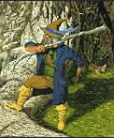The Naming of the Noldor
This how the naming of children was achieved among the Noldor. An initial name was given to the child at birth, and any number of up to four other types of names could be bestowed upon the elf through their life. To add to an already confusing subject, when the Noldor returned to Middle-earth, the true Quenyan names were often mutated into Sindarin forms.
True Names
There were three forms of true Noldorin names – the father-name, the mother-name and the chosen-name.
The father-name
Soon after the birth of the elf-child, the father devised the first name for the child – this was called the father-name and it usually recalled the name of the father, or it could even simply be the father’s name with a prefix added. It was the father who announced the name to the child’s kin at a ceremony called the Essecarmë (Name making).
One of the best examples of the names of the children being close to the father’s name is the lineage of Finwë. His son Fëanor’s Quenya name was Curufinwë (Kurufinwë). In turn, Fëanor’s children also included the name of Finwë in their Quenya names.
| Sindarin | Quenya | Quenya meaning | Mother-name | Mother name meaning |
| Maedhros | Nelyafinwë | “Third Finwë in succession” | Maitimo | “Well-shaped one”. Maedhros was of beautiful bodily form, with the rare russet-red hair of Nerdanel’s kin. |
| Maglor | Kanafinwë | “Strong-voiced Finwë” | Makalaurë | Uncertain meaning. Usually interpreted as “forging gold” |
| Celegorm | Turkafinwë | “Powerful Finwë” | Tyelkormo | “Hasty-riser”. Because of his quick temper and his habit of leaping up when suddenly angered. |
| Curufin | Kurufinwë | Fëanor’s own name | Atarinkë | “Little father”. Refers to his physical likeness to Fëanor. |
| Caranthir | Morifinwë | “Dark Finwë” | Carnistir | “Red face”. He was brown haired, but had the ruddy complexion of his mother. |
| Amrod | Pityafinwë | “Little Finwë” | Ambarto | Either “Fated” or “Exalted” |
| Amras | Telufinwë | “Last Finwë” | Ambarussa | “Top Russet”. Like Maedhros, he had the rare russet-red hair of Nerdanel’s kin. |
Mother-name
Another name was given to the elf by their mother – sometimes soon after birth, but often later in their life. These were names entirely of the mother’s own choosing, the most significant of which were the essi tercenyë (names of insight) and the apacenyë (names of foresight). These indicated some dominant feature of the child’s nature as perceived by their mother, or some foresight of the child’s fate.
A well-example example of a mother-name is Fëanáro (Fëanor), the name given to Curufinwë by Miriel.
Chosen name
Every child of the Noldor also had the right to name themselves in a later ceremony called the Essecilmë (Name Choosing). This took place at no particular fixed date after Essecarmë, but it was only performed when the elf-child was able to devise words and sounds. Essecilmë usually took place at or around the end of the tenth year of the elf-child.
An example of this type of name would be Sindicollo (Greycloak), the chosen name of Elwë, which was of course mutated into Thingol in the Sindarin tongue.
While the father name was public to everyone, the chosen name was private and only used by family and close friends. Elves would find it insulting for strangers to use their chosen name without permission.
After a few years the elf might want a new chosen name but this did not abrogate the former one, and it was not a common occurrence.
Other names
Epessë (“after-name”)
The epessë was a ‘nickname’, generally given as a title of admiration or honour.
Kilmessi (“names of personal choice”)
Among the Noldorin exiles, there was a tendency to give themselves other names, as disguises or in reference to their own deeds and personal history.
References
– Morgoth’s Ring
– People of Middle-earth (The Shibboleth of Fëanor)









